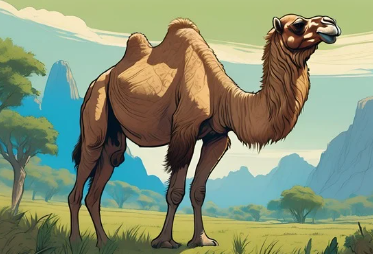The Characteristics and Uses of Camel Down
Camel down, also known as camel wool or camel hair, is a unique and valuable natural fiber that has been prized for centuries due to its softness, warmth, and insulating properties. This fiber comes from the undercoat of camels, primarily the Bactrian camel (a two-humped camel) and the dromedary camel (a single-humped camel), both of which are native to harsh, cold environments like the deserts of Central Asia. While not as widely known as some other animal fibers, camel down offers a variety of benefits and has numerous uses in textiles and beyond.
Characteristics of Camel Down
-
Softness: Camel down is one of the softest natural fibers available. It is finer and softer than many other animal fibers, including sheep wool, making it comfortable and non-itchy against the skin.
-
Warmth and Insulation: Camel down is an excellent insulator due to its unique structure. The fiber has hollow cores that trap air, which makes it a superb thermal insulator. This property is essential for camels to survive in extreme temperature variations—hot days and freezing nights in desert environments.
-
Breathability and Moisture-Wicking: Camel down also excels in its ability to regulate body temperature and wick moisture away from the skin. It allows for the proper air circulation, making it ideal for use in both cold and slightly warmer environments.
-
Lightweight: Despite its exceptional warmth, camel down is incredibly lightweight, which adds to its appeal for use in clothing and bedding. This lightweight quality makes garments made from camel down particularly comfortable for extended wear.
-
Durability: Camel down fibers are known for being strong and resilient. They can withstand wear and tear, which makes them a practical choice for high-use textiles such as coats and blankets.
-
Hypoallergenic: Camel down is naturally hypoallergenic, meaning it is less likely to cause skin irritation or allergic reactions when worn next to the skin. This makes it a popular choice for people who have sensitivities to wool or other animal fibers.
Types of Camel Down
There are two primary types of camel down:
- Undercoat (or Down): This is the soft, fine, and fluffy fur found beneath the camel’s outer layer. It is the most prized for textile use because of its warmth and softness.
- Guard Hair: These are longer, coarser fibers found on the camel's outer coat. While not as soft as the down, they are still used in some textile applications and can be spun into yarn for more durable fabrics.
Uses of Camel Down
-
Textiles and Clothing: Camel down is primarily used in the production of high-quality garments such as coats, shawls, and scarves. Due to its warmth, lightweight nature, and softness, camel wool is particularly sought after for winter clothing. The fabric made from camel down is often blended with silk or other fibers to enhance its texture and durability. Some luxury brands also incorporate camel down into their collections for its high-end appeal.
-
Bedding: Camel down is often used in the creation of blankets, comforters, and duvets. Its insulating properties provide warmth in cold climates, while its breathability helps keep sleepers comfortable by preventing overheating. Many people find camel down bedding a perfect balance between warmth and comfort, as it adjusts to the body’s temperature needs.
-
Carpets and Rugs: In regions where camels are commonly raised, camel down fibers are woven into carpets and rugs. These textiles often feature intricate designs and are known for their softness underfoot. Camel hair rugs are highly valued in many cultures, particularly for their insulating properties and natural sheen.
-
Textile Blends: Camel down is sometimes blended with other natural fibers like wool or cotton to create fabrics that balance the best properties of each. For example, a blend of camel hair and cashmere results in an ultra-soft, luxurious fabric that is warm yet lightweight. Such blends are often used for premium clothing, scarves, and other accessories.
-
Sustainable Fashion: With a growing interest in sustainable and eco-friendly fashion, camel down is becoming more popular in ethical fashion lines. Unlike synthetic fibers, camel down is biodegradable and has a minimal environmental impact when sourced responsibly. Because camels naturally shed their undercoat each year, camel down is collected without causing harm to the animals.
-
Traditional and Cultural Uses: In some regions, camel down has been traditionally used for practical purposes like making tents, ropes, and sacks. Camel hair has historically been spun into yarn to create durable, long-lasting textiles for everyday use in harsh climates.
Advantages of Camel Down Over Other Fibers
-
Superior Insulation: Camel down is considered a superior insulator compared to sheep wool. While both offer warmth, camel down is lighter and better at regulating body temperature, making it ideal for use in clothing and bedding.
-
Eco-Friendly: Since camel hair is gathered from the shedding process, it is a renewable resource. Furthermore, camel farming tends to have less environmental impact than other animal husbandry practices, which makes camel down a more sustainable choice compared to some other animal fibers.
-
Comfort and Versatility: Camel down's versatility is one of its key selling points. Its softness, warmth, and lightweight properties make it suitable for both cold-weather gear and fashion pieces.
Conclusion
Camel down is a remarkable natural fiber with a variety of characteristics that make it highly valued in the textile industry. Its softness, warmth, breathability, and hypoallergenic properties give it an edge over other animal fibers, while its lightweight and durable nature make it a preferred choice for luxurious garments and bedding. As demand for sustainable and eco-friendly fashion continues to grow, camel down is poised to become even more prominent in the global market. Whether in winter coats, bedding, or traditional textiles, camel down continues to play an important role in human culture and craftsmanship.


